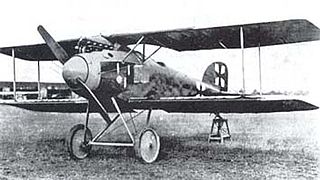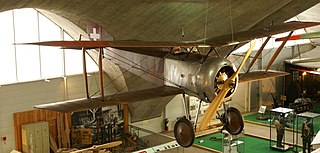
The Fokker Scourge occurred during the First World War from July 1915 to early 1916. Imperial German Flying Corps units, equipped with Fokker Eindecker fighters, gained an advantage over the Royal Flying Corps (RFC) and the French Aéronautique Militaire.

A synchronization gear was a device enabling a single-engine tractor configuration aircraft to fire its forward-firing armament through the arc of its spinning propeller without bullets striking the blades. This allowed the aircraft, rather than the gun, to be aimed at the target.

The Nieuport 17 C.1 was a French sesquiplane fighter designed and manufactured by the Nieuport company during World War I. An improvement over the Nieuport 11, it was a little larger than earlier Nieuports and better adapted to the more powerful engine than the interim Nieuport 16. Aside from early examples, it had the new Alkan-Hamy synchronization gear, permitting the use of a fuselage-mounted synchronised Vickers gun firing through the propeller disc.

World War I was the first major conflict involving the large-scale use of aircraft. Tethered observation balloons had already been employed in several wars, and would be used extensively for artillery spotting. Germany employed Zeppelins for reconnaissance over the North Sea and Baltic and also for strategic bombing raids over Britain and the Eastern Front.

The Airco DH.2 was a single-seat pusher biplane fighter aircraft which operated during the First World War. It was the second pusher design by aeronautical engineer Geoffrey de Havilland for Airco, based on his earlier DH.1 two-seater.

The Royal Aircraft Factory S.E.5 was a British biplane fighter aircraft of the First World War. It was developed at the Royal Aircraft Factory by a team consisting of Henry Folland, John Kenworthy and Major Frank Goodden. It was one of the fastest aircraft of the war, while being both stable and relatively manoeuvrable. According to aviation author Robert Jackson, the S.E.5 was: "the nimble fighter that has since been described as the 'Spitfire of World War One'".

The Sopwith 1+1⁄2 Strutter was a British single- or two-seat multi-role biplane aircraft of the First World War. It was the first British two-seat tractor fighter and the first British aircraft to enter service with a synchronised machine gun. It was given the name 1+1⁄2 Strutter because of the long and short cabane struts that supported the top wing. The type was operated by both British air services and was in widespread but lackluster service with the French Aéronautique Militaire.

In aviation, the term tractor configuration refers to an aircraft constructed in the standard configuration with its engine mounted with the propeller in front of it so that the aircraft is "pulled" through the air. Oppositely, the pusher configuration places the airscrew behind and propels the aircraft forward. Through common usage, the word "propeller" has come to mean any airscrew, whether it actually propels or pulls the plane.

The Albatros D.II was a German fighter aircraft used during World War I. After a successful combat career in the early Jagdstaffeln, it was gradually superseded by the Albatros D.III.

The Nieuport 11, nicknamed the Bébé, was a French World War I single seat sesquiplane fighter aircraft, designed by Gustave Delage. It was the primary aircraft that ended the Fokker Scourge in 1916. The type saw service with several of France's allies, and gave rise to the series of "vee-strut" Nieuport fighters that remained in service into the 1920s.

The Bristol Scout was a single-seat rotary-engined biplane originally designed as a racing aircraft. Like similar fast, light aircraft of the period it was used by the RNAS and the RFC as a "scout", or fast reconnaissance type. It was one of the first single-seaters to be used as a fighter aircraft, although it was not possible to fit it with an effective forward-firing armament until the first British-designed gun synchronizers became available later in 1916, by which time the Scout was obsolescent. Single-seat fighters continued to be called "scouts" in British usage into the early 1920s.

The Nieuport 28 C.1, a French biplane fighter aircraft flown during World War I, was built by Nieuport and designed by Gustave Delage. Owing its lineage to the successful line of sesquiplane fighters that included the Nieuport 17, the Nieuport 28 continued a similar design philosophy of a lightweight and highly maneuverable aircraft.

The Sopwith 5F.1 Dolphin was a British fighter aircraft manufactured by the Sopwith Aviation Company. It was used by the Royal Flying Corps and its successor, the Royal Air Force, during the First World War. The Dolphin entered service on the Western Front in early 1918 and proved to be a formidable fighter. The aircraft was not retained in the postwar inventory and was retired shortly after the war.

The Hanriot HD.1 was a French World War I single-seat fighter aircraft. Rejected for service with French squadrons in favour of the SPAD S.VII, the type was supplied to the Belgian Army′s Aviation Militaire Belge and the Royal Italian Army′s Corpo Aeronautico Militare, with both of which it proved highly successful. Of a total of about 1,200 examples built, 831 were produced by Italian companies under licence.

The Royal Aircraft Factory F.E.8 was a British single-seat fighter of the First World War designed at the Royal Aircraft Factory. It could not escape the drag penalty imposed by its tail structure and was no match for the Albatros fighters of late 1916.
The Nieuport B.N.1 was a prototype British single-engined fighter aircraft of the First World War. It was a single-engined biplane intended to replace the Sopwith Camel, but only one was built, being destroyed in a crash. The Sopwith Snipe was built instead to replace the Camel.
The Sopwith Long Range Tractor Triplane (L.R.T.Tr) was a prototype British long-range three-seat triplane escort fighter of the First World War. Its unusual layout had a small gunner's nacelle mounted on the upper wing for an all-round field of fire. Only a single example was built, as other, smaller fighters proved more practicable.
The Sopwith Snark was a British prototype fighter aircraft designed and built towards the end of the First World War to replace the RAF's Sopwith Snipes. A single engined triplane, the Snark did not fly until after the end of the war, only three being built.

The Nieuport 16 C.1 was a French World War I single-seat sesquiplane fighter aircraft, designed by Gustave Delage as a development of the Nieuport 11 with a more powerful engine. The Nieuport 16's service life coincided with the period when the first air-to-air rockets, the Le Prieur rocket, were used most frequently, and the type has a closer association with them than any other aircraft.

The Nieuport 17bis C.1 was a World War I French single-seat sesquiplane fighter that was produced under licence in the United Kingdom in small numbers for the Royal Naval Air Service.
























